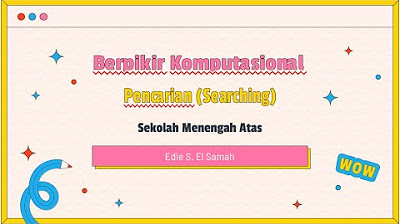03. New Berpikir Komputasional - Pencarian (Searching) - Informatika Kelas X
Summary
TLDRThis video lesson introduces computational thinking, focusing on search algorithms and their practical applications. It explains four core principles: decomposition (breaking problems into smaller parts), pattern recognition (identifying trends to predict solutions), abstraction (focusing on relevant details), and algorithms (step-by-step problem-solving). The video encourages students to understand how searching works in both everyday life and computing, highlighting the importance of strategy in finding solutions efficiently. By applying these principles, students can improve their problem-solving skills in various contexts, from academic challenges to real-life tasks like searching for a book or a lost item.
Takeaways
- 😀 Computational thinking involves systematic problem-solving using concepts and principles from computer science.
- 😀 Problem decomposition helps break down complex problems into smaller, manageable parts, making them easier to solve.
- 😀 Pattern recognition allows individuals to identify trends in data, which aids in making predictions or decisions.
- 😀 Abstraction involves focusing only on the relevant details of a problem, helping avoid unnecessary complexity.
- 😀 Algorithms are step-by-step logical procedures designed to solve problems efficiently.
- 😀 Computational thinking is not limited to computer science; it applies across various fields and enhances critical thinking and creativity.
- 😀 Searching is a fundamental problem in both daily life and computing, where one must find an object or information that meets specific criteria.
- 😀 Effective searching strategies depend on the context, such as whether objects are organized systematically or randomly.
- 😀 In real-life scenarios like finding a book in a library or a lost item at home, more efficient strategies can significantly reduce search time.
- 😀 Developing computational strategies for problem-solving can increase both efficiency and effectiveness in everyday tasks and complex issues.
Q & A
What is computational thinking?
-Computational thinking is an approach to problem-solving that involves using concepts and principles from computer science. It involves breaking down complex problems into smaller, manageable parts, recognizing patterns, applying abstractions, and designing algorithms to solve the problem efficiently.
Why is computational thinking important in today's world?
-Computational thinking is increasingly important because it helps in solving complex problems systematically and logically, which is essential in a world dominated by technology and data. It fosters critical thinking, creativity, and efficient problem-solving in various fields, not just computer science.
What are the four foundations of computational thinking?
-The four foundations of computational thinking are: 1) Decomposition, which breaks a complex problem into smaller parts; 2) Pattern Recognition, which identifies trends or regularities; 3) Abstraction, which focuses on relevant information by ignoring unnecessary details; 4) Algorithms, which are step-by-step instructions to solve a problem or perform a task.
How does decomposition help in problem-solving?
-Decomposition helps by breaking a complex problem into smaller, more manageable parts. This allows individuals to focus on solving each part separately, making the overall problem easier to tackle.
What role does pattern recognition play in computational thinking?
-Pattern recognition involves identifying trends or similarities within data or a problem. It allows individuals to make predictions or decisions more easily by applying known solutions to similar problems.
How does abstraction contribute to solving problems efficiently?
-Abstraction helps by removing unnecessary details and focusing only on the relevant information. This allows individuals to address the core issue without being distracted by complex or irrelevant data.
What is the purpose of an algorithm in computational thinking?
-An algorithm is a sequence of logical, ordered steps designed to solve a specific problem or perform a task. It serves as a clear blueprint for achieving a solution efficiently.
Can computational thinking be applied outside of computer science? How?
-Yes, computational thinking can be applied in various fields outside of computer science. It helps individuals tackle complex problems in areas like business, medicine, engineering, and everyday life by encouraging logical, systematic approaches to problem-solving.
What is an example of searching in daily life as described in the transcript?
-An example of searching in daily life is when you search for a book in a library or look for a lost item, like a shirt. The process involves finding an object that meets specific criteria within a collection of other objects.
What are some strategies for efficient searching?
-Efficient searching strategies include organizing items in a systematic way, such as arranging books in a library by title, or using logical methods to check items (e.g., checking a drawer in a systematic order), which reduces the time spent looking for something.
Outlines

This section is available to paid users only. Please upgrade to access this part.
Upgrade NowMindmap

This section is available to paid users only. Please upgrade to access this part.
Upgrade NowKeywords

This section is available to paid users only. Please upgrade to access this part.
Upgrade NowHighlights

This section is available to paid users only. Please upgrade to access this part.
Upgrade NowTranscripts

This section is available to paid users only. Please upgrade to access this part.
Upgrade NowBrowse More Related Video

Pencarian (Searching) - Informatika Kelas X

RANGKUMAN BAB 2 - INFORMATIKA KELAS 9 - STRUKTUR DATA MODEL GRAPH AND TREE

04. New Berpikir Komputasional - Pengurutan (Sorting) - Informatika Kelas X

Yuk, Berpetualang di Dunia Algoritma SMP Kelas 9! | Materi Informatika Elemen Berpikir Komputasional

#1 Berpikir Komputasional Kelas 8 (Fungsi-Algoritma-Struktur Data) - Kumer | Pelajar Hebat

Berpikir Komputasional dan Algoritma Pemrograman - Berpikir Komputasional - Informatika Kelas XII
5.0 / 5 (0 votes)